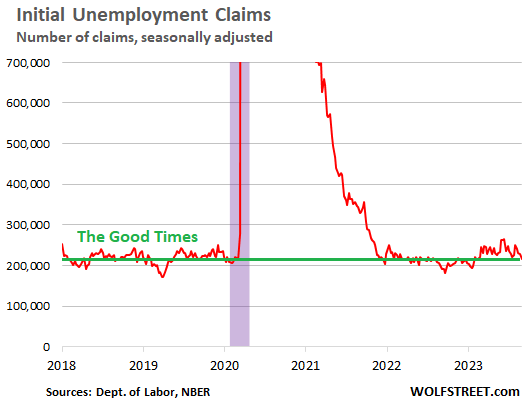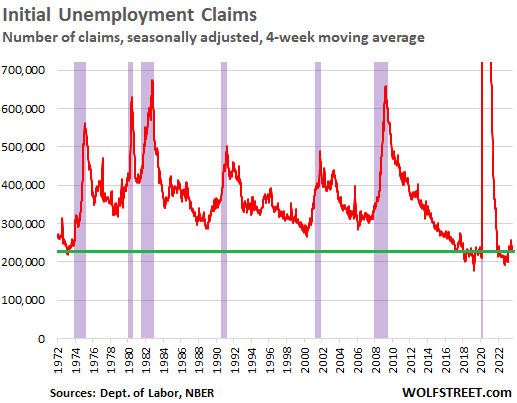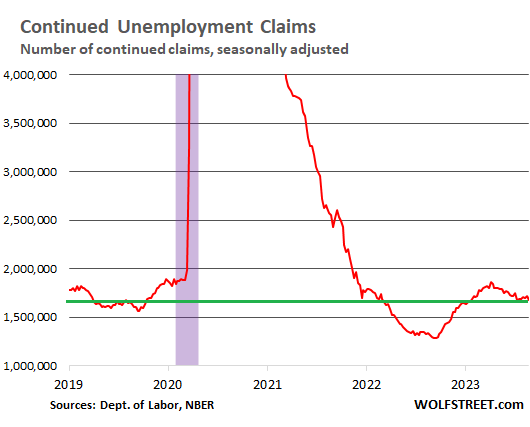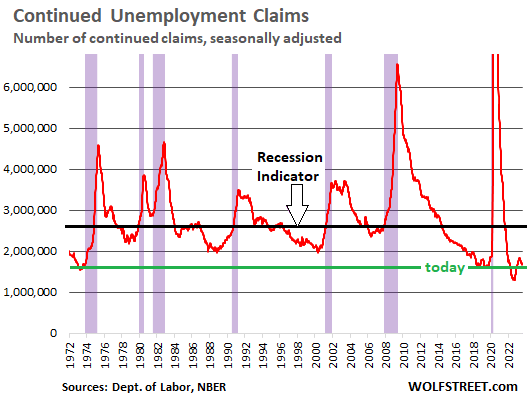This is Naked Capitalism fundraising week. 467 donors have already invested in our efforts to combat corruption and predatory conduct, particularly in the financial realm. Please join us and participate via our donation page, which shows how to give via check, credit card, debit card, or PayPal. Read about why we’re doing this fundraiser, what we’ve accomplished in the last year,, and our current goal, continuing our expanded news coverage.
Yves here. Wolf Richter is sometimes criticized for having a bearish bias, so his seeing a recession as not imminent is a meaningful sign. Note other sites that do a fair bit of date-watching like Angry Bear also see the latest initial unemployment claims report as significant.
By Wolf Richter, editor of Wolf Street. Originally published at Wolf Street
We’ve been on a recession watch here ever since the Fed started hiking rates. Sharp increases in weekly claims for unemployment insurance benefits – especially “continued claims” – are highly correlated with recessions. So we keep an eye on it from time to time. The data did show some weakening from September 2022 into early 2023, but remained in the range of the Good Times lows, and in recent months, the signals backtracked, as unemployment claims fell. The expectations of a recession this year have been cancelled months ago, and by now, there’s no recession in sight. Maybe next year, maybe whenever.
Initial Claims Backtracked into the Good Times.
Initial claims for state unemployment insurance benefits by people who’ve lost their jobs fell to 216,000 in the latest reporting week, according to the Labor Department today. This was the lowest since February. The number has been wobbling lower since the end of June:

The four-week moving average, which irons out the week-to-week ups and downs, declined to 229,000, a historically low number that has been seen over the past 50 years only in the two years just before the pandemic and in the hot labor market coming out of the pandemic.
This is the view of the four-week moving average going back 50 years, with recessions indicated in purple. Note how unemployment claims begin to surge shortly before recessions begin:
- By December 2007, the official beginning of the recession, initial claims were piercing 340,000.
- By March 2021, the official beginning of the recession, initial claims were piercing 380,000.
- In the three recessions in the 1980s and 1990s, initial claims were spiking through 400,000.
So the labor market today, as seen by claims for unemployment insurance benefits, lost just a little steam late last year and earlier this year as the layoffs started to show up in the numbers, but it has regained some of the lost steam and remains solidly in the range of the Good Times.

“Continued Claims” Backtrack into the Good Times.
The number of people who are still claiming unemployment insurance at least one week after the initial application – people who haven’t found a job yet – has meandered lower since April, and in the latest reporting week dropped to 1.69 million, back where it had been in February.
It means that fewer people are losing their jobs, and those that do lose their jobs, find new jobs more quickly than late last year and earlier this year and come off the unemployment-benefit rolls faster.

The Recession Indicator
Recessions from the Great Recession back through the early 1980s began when continued claims for unemployment insurance spiked through about the 2.6-million mark.
So this 2.6 million line (black) for continued-claims is one of our recession indicators – and my favorite. But continued claims have been backtracking since April, and today’s level of 1.69 million is far below recessionary levels, and has been pulling further away from the recession line:

The long-term view shows that the labor market, as depicted by people continuing to claim unemployment benefits, has strengthened since April, after having weakened a little in late 2022 and early 2023. But throughout this period, it has remained historically tight, and even at the worst point earlier this year, it was in the range of the Good Times just before the pandemic, and much tighter than in the prior 50 years.
What the labor market is telling the recession watchers here is that there is no recession in sight. There will be a recession someday – there always eventually is a recession – but it is not in sight, and we’ll just have to keep watching for it.
We’re seeing similar labor market indicators from other directions, such as the spectacle of a surging labor force in August, and the sharply dropping layoffs and discharges, after the acceleration earlier this year.


Could it be that it’s impossible to be in a recession while the US Federal government is running such a large deficit? I think that’s what Mosler has been trying to say.
Really? Has anyone ever linked recessions to federal budget deficits? If so, I haven’t seen it.
This is non-traditional, but I interface with the demolition industry a lot. One company owner (he’s second generation and has been the owner for 30+ years) told me that demo is the leading indicator for recession. I’m still seeing bids for demo jobs being significantly lower than expected, indicating that companies aren’t finding enough work. The owner who told me this rule of thumb won a bid in late spring and also told me he shaved $1M off the price he would have bid because he needed the revenue. And this is during a time where the state is throwing tens of millions in blight elimination grants around.
Employment in construction / demolition is still really tight though. But I can’t say how much of that is because of strong business vs just not enough workers in the trades. The environmental work necessary for commercial real estate transactions and development preparation is still barely existent.
What’s interesting to me here, is that despite what we know about SARS-COV-2 infection, the economy continues to rumble on. It’s hard to square that circle mentally. I read another report last week or thereabouts that showed the prime working age employment rate is now slightly higher than just before the Pandemic. I’m not sure how that tracks with long-COVID and an increasing disabled populace. All puzzling. Maybe this will play out over a much longer time frame, or having an increasingly sick populace is not at odds with capitalism continuing to march onward.
Coincidence? Just 10 minutes ago on NPR there was a very brief report about the current repudiation by top economists of the Phillips curve. Fifteen years after NC began pointing out that the Phillips Curve was nonsense. Full employment does not cause inflation so it isn’t necessary to attack labor to force a recession. How convenient, just when the consensus is to go forward with trillions for Build Back Better. Not that it’s a bad idea – Build Back Better is the only option right now and our obligation is to make sure it is better. I sense a new monetary protocol. Maybe because we really can’t afford to pay all that interest on our treasuries? Which interest probably aggravated inflation the most and up until now we have used the dollar and the military to control foreign relations, so we messed around with it as necessary and blew smoke about our overheated economy. Maybe.
Real household income (adjusted for inflation) has been steadily rising for the past decade (since the GFC). As long as this continues, recessions are hard to come by.
See St. Louis Fed’s graph.
Covid caused about 18 months of materials / supply chain disruptions. That part of inflation actually turned out to be (relatively) “temporary”.
Covid also appears to have caused or at least triggered a longer-term labor shortage, resulting in higher wages for many.
As long as wages remain high / going higher, it’s tough to get a recession. Yes, we got a lot of inflation, but wages seem to be keeping up. Note that the Fed’s graph above is adjusted for inflation, so that’s actual buying power.
There’s another aspect of this phenomena worth reporting, and this also comes from Wolf Richter. There’s quite a bit of new industrial construction going on as production is repatriated from China.
Those new factories are more automated than the ones left behind in China, and this is likely to reduce the magnitude of the favorable impact in mfg’g employment. It’s great for construction employment in the medium (10 yrs) term, no question of that, and it’s great for the materials sector (cement, aggregates, steel, factory equipment).
These are probably good things, generally speaking. They’d be better things if the production processes were producing goods that:
a. Last a very long time
b. Are composed of recoverable materials, and
c. Are made in distributed facilities in order to reduce the transportation req’mts of both materials sourcing and worker transit
“it’s great for the materials sector (cement, aggregates, steel, factory equipment)”
And that’s disastrous for the Earth and, ultimately, to us.
We continue to pursue goals like full employment, increasing consumption, GDP growth, that are completely contrary to the goal of minimizing activity while provisioning necessities. Will we ever outgrow Consumption Fever and Happy Motoring?
“Let’s all drive our big pickups through creeks and see how many minnows and tadpoles we can kill!”
Couldn’t agree more, Henry.
And that’s why I added “made to last” and “composed of recoverable materials” and “minimize transport”.
As has been recently discussed here @ NC, humans are herd animals, and have great difficulty adopting behaviors which run counter to the herd’s prevailing mood.
My way of stepping outside the herd is to a) learn how to do new product development, and b) elevate the performance criteria set out above to the ordinal place in the new product’s “requirements” spec (e.g. what the product has to be and do in order to be acceptable).
The other day, here at NC, we observed a new hydrogen production plant that burned carbon black (byproduct of petroleum refining), and injected the CO2 into the ground. It’s sorta detestable. Certainly it’s a lame attempt to keep the fossil fuel industry alive longer in order to maximize return on (sunk) investment.
If we continue to delegate (abdicate?) our role(s) in product development to the current crop of “industry leaders”, we’ll get more products like that very disappointing hydrogen project.
I want products that honor _my_ values. I am so desperate to get them, I’m resorting to designing and building them myself.
What essential products will these factories produce? Will people be able to eat those products? Sleep in them? Will these products in some way reduce atmospheric carbon, not in the sense of makes less carbon than before, but actually reduce it? Will they improve the soil or water quality?
We’re a bit beyond the point of producing things more efficiently from a carbon standpoint unless they’re essential, aren’t we? Fewer products are what we need. Fewer jobs. No new construction unless essential for some special reason. This would need to be accompanied by a huge wealth and income redistribution program.
What essentials? Good question. I’ve set out above the nature / core dimensions of performance of any product that I would design and produce.
Of course, these new factories and the products they produce will likely not embody my values (and yours, judging from your remarks).
So yes, we need fewer, but better products. We need houses and cars and office buildings that don’t bleed heat. We need appliances that last for decades. We need nutrient and materials cycling systems to replace our landfills.
Those kind of products are the ones I want.
And if the little people (like you and me) designed and built the production systems for those kind of products, then we would enable and then execute a huge _creation_ of wealth-generating capacity, and put it into the hands of the many.
Let the rich hold on to their obsolete production systems. Let the little people create and own the production systems of tomorrow, Henry. That will solve many, maybe most of the problems you set out above.
IMO jobs should increase. As per New Deal. There are lots of things for nurses to do all shift, but I remember some conched out with heads on desk in an ICU. Put more on the staff. Some will at first sit more maybe than they should, but eventually they’ll see where they’re needed. This country is broke down, and needs more care givers.
IMO it’s helpful to look at the worst places…just to get bearings. From what I see the worst situations are getting larger in size, which may be proportional to the commercial real estate problem? Worst places are maybe international trends, but the equivalent of this below is in Philly and Boston too (not as congested; check Kensington Av in Philly, and Sabby Sabs re Boston).
https://www.facebook.com/photo/?fbid=829353105413681&set=a.229886528693678
Products should be geared to crises we’ve been ignoring, or potential ones (Cuba’s method). The net seems to tie humans for being reed-like, the frailest two things in nature?
https://www.wired.com/story/sun-storm-end-civilization/
Wired’s politics is weird, but I found the above interesting.
We had a major disruption in labor supply, and it’s going to take a few years for rules of thumb to adjust: Wolf’s 2.6m line, 2 down quarters, the Sahm Rule, etc. are suspect until maybe 2025.
Also, we have now entered the Age Of Angry Weather, which will rearrange expectations and priorities.